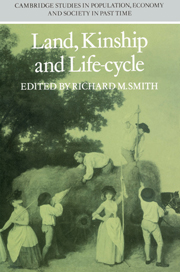Book contents
- Frontmatter
- Contents
- List of contributors
- Preface
- 1 Some issues concerning families and their property in rural England 1250–1800
- 2 Population pressure, inheritance and the land market in a fourteenth-century peasant community
- 3 Families and their land in an area of partible inheritance: Redgrave, Suffolk 1260–1320
- 4 Population changes and the transfer of customary land on a Cambridgeshire manor in the fourteenth century
- 5 Industrial employment and the rural land market 1380– 1520
- 6 Changes in the size of peasant holdings in some west midland villages 1400–1540
- 7 The erosion of the family–land bond in the late fourteenth and fifteenth centuries: a methodological note
- 8 Changes in the link between families and land in the west midlands in the fourteenth and fifteenth centuries
- 9 Kinship in an English village: Terling, Essex 1550–1700
- 10 The myth of the peasantry: family and economy in a northern parish
- 11 Poverty, poor relief and the life-cycle: some evidence from seventeenth-century Norfolk
- 12 The receipt of poor relief and family situation: Aldenham, Hertfordshire 1630–90
- 13 Widows in pre-industrial society: an essay upon their economic functions
- 14 Real property, marriage and children: the evidence from four pre-industrial communities
- 15 The nineteenth-century peasantry of Melbourn, Cambridgeshire
- Consolidated Bibliography
- Index
6 - Changes in the size of peasant holdings in some west midland villages 1400–1540
Published online by Cambridge University Press: 19 October 2009
- Frontmatter
- Contents
- List of contributors
- Preface
- 1 Some issues concerning families and their property in rural England 1250–1800
- 2 Population pressure, inheritance and the land market in a fourteenth-century peasant community
- 3 Families and their land in an area of partible inheritance: Redgrave, Suffolk 1260–1320
- 4 Population changes and the transfer of customary land on a Cambridgeshire manor in the fourteenth century
- 5 Industrial employment and the rural land market 1380– 1520
- 6 Changes in the size of peasant holdings in some west midland villages 1400–1540
- 7 The erosion of the family–land bond in the late fourteenth and fifteenth centuries: a methodological note
- 8 Changes in the link between families and land in the west midlands in the fourteenth and fifteenth centuries
- 9 Kinship in an English village: Terling, Essex 1550–1700
- 10 The myth of the peasantry: family and economy in a northern parish
- 11 Poverty, poor relief and the life-cycle: some evidence from seventeenth-century Norfolk
- 12 The receipt of poor relief and family situation: Aldenham, Hertfordshire 1630–90
- 13 Widows in pre-industrial society: an essay upon their economic functions
- 14 Real property, marriage and children: the evidence from four pre-industrial communities
- 15 The nineteenth-century peasantry of Melbourn, Cambridgeshire
- Consolidated Bibliography
- Index
Summary
In examining the developments in the size of peasant holdings in the later middle ages historians have tended to concentrate on long-term structural changes in the social distribution of land. One school of thought argues that as a result of the drastic loss of population from the mid-fourteenth century ‘economic promotion’ took place, which meant that all groups within the peasantry increased the size of their holdings. Others see differentiation at work, by which peasant society became more polarized between tenants of large holdings and wage earners, and which foreshadows the dichotomy between capitalist farmers and labourers in modern times.
Neither explanation is fully satisfactory. The promotion theory is perhaps too simplistic, and fails to explain some very large holdings that developed, while the stagnant market for agricultural produce in much of the period would not have made an ideal environment for differentiation.
It is also necessary to take into account the small-scale and short-term changes in the size of peasant holdings, dependent on the circumstances of individual families. This factor has attracted more attention recently because of the translation into English of the writings of the Russian agricultural economist, A. V. Chayanov, who developed the concept of the peasant holding as a ‘family farm’, in which the consumption needs and labour contribution of the family helped to determine the size of the holding.
- Type
- Chapter
- Information
- Land, Kinship and Life-Cycle , pp. 277 - 294Publisher: Cambridge University PressPrint publication year: 1985

